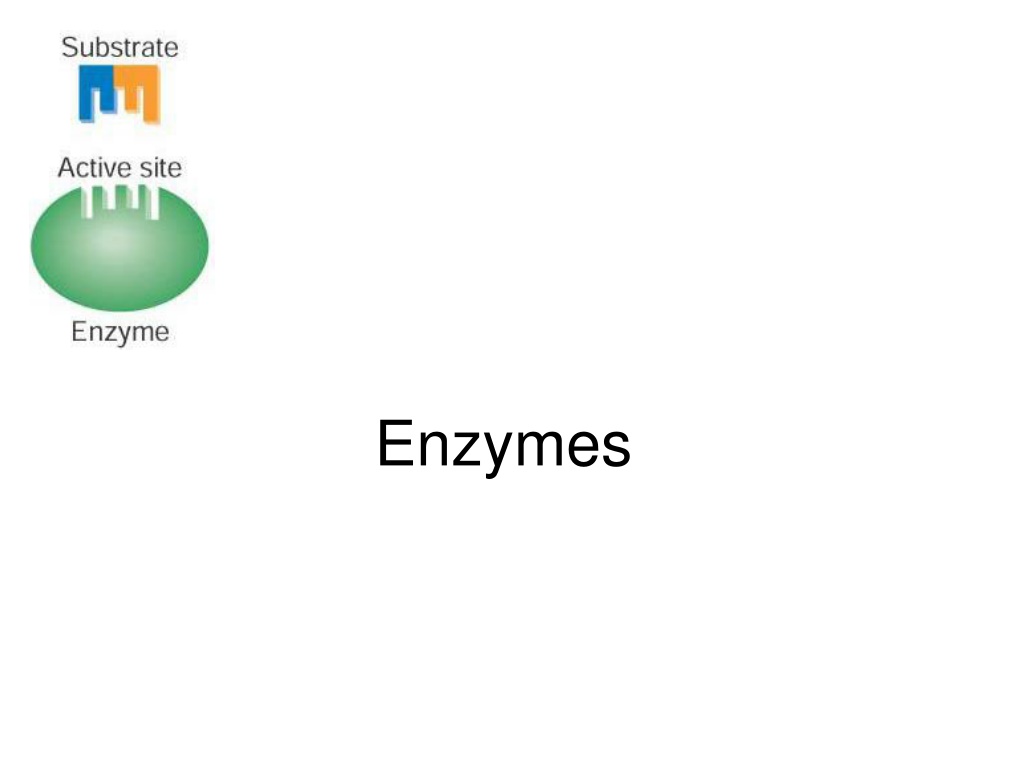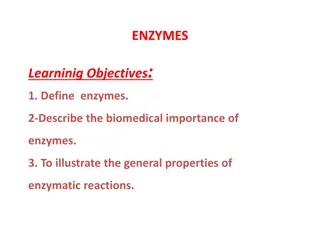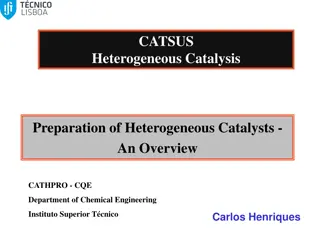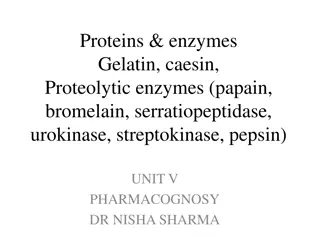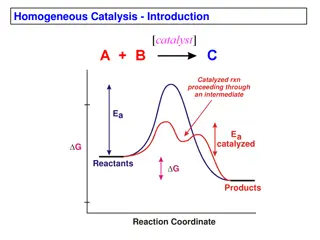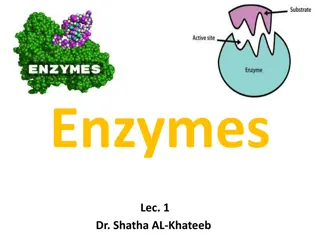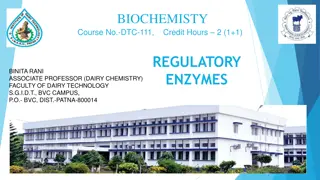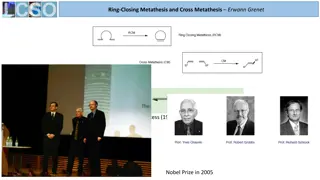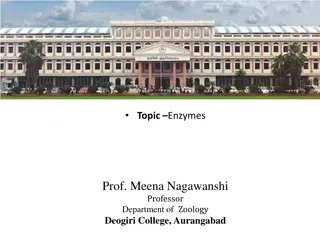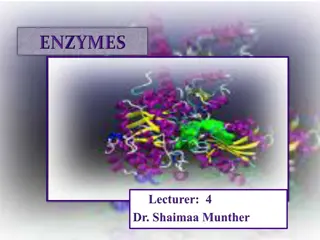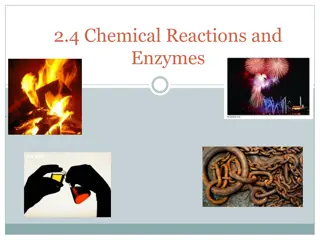Understanding Enzymes: The Catalysts of Cellular Reactions
Enzymes play a vital role in controlling cellular reactions by speeding up processes without being consumed themselves. They are biological catalysts made of proteins, with each enzyme having a specific shape for its designated molecule. This summary highlights the importance of enzymes in cellular functions and their unique 3D structures.
Uploaded on Sep 20, 2024 | 0 Views
Download Presentation

Please find below an Image/Link to download the presentation.
The content on the website is provided AS IS for your information and personal use only. It may not be sold, licensed, or shared on other websites without obtaining consent from the author. Download presentation by click this link. If you encounter any issues during the download, it is possible that the publisher has removed the file from their server.
E N D
Presentation Transcript
snapped%2520steps%25201 Reactions Most reactions take place in a number of steps which need to be carefully controlled if the cell is to function properly Enzymes are the most important controllers of cellular reactions
Catalysts Catalysts speed up reactions without themselves being involved in the reaction Enzymes are catalysts made of protein they speed up a reaction without being used up themselves in the reaction Because enzymes are made in living things they are called biological (or organic catalysts)
We learned in the chapter on food that proteins are made when amino acids join together The function of a protein is decided not only by the sequence of amino acids but also by the way the protein folds Most enzymes are globular proteins
Learning Check What is an Enzyme? What are catalysts? To what group of bio-molecules do enzymes belong?
How enzymes work Enzymes are not flat they have a 3D structure
Each enzyme has its own specific shape that will only fit the molecule that the enzyme is designed to work on If the enzyme that breaks starch into glucose meets a fat molecule it will not fit it and will not be able to work on it
A movie on the action of Enzymes! http://www.bishopstopford.com/faculties/sc ience/arthur/?sortby=3 http://www.angelo.edu/faculty/nflynn/Bioch emistry/ http://www.angelo.edu/faculty/nflynn/Biochemistry/
Learning Check Why is the shape of an enzyme important? Are enzymes flat, 3D or 2D in shape?
Enzyme Action The substance that an enzyme acts on is its substrate The substance(s) that the enzyme forms is called the product(s) starch%2520and%2520amylase
A Catabolic enzyme Amylase converts starch to maltose Catabolic as it breaks a big molecule into a smaller one It is produced by saliva glands in mouth and by the pancreas ah6a192
An Anabolic Enzyme DNA Polymerase forms and repairs DNA Anabolic as it coverts simpler molecules into more complex molecules Found in almost all living things
Consider This Amylase is an enzyme found in saliva. It breaks starch molecules into smaller maltose molecules What is the substrate? What is the product? Will amylase break fats into fatty acids + glycerol? Why? Is this an example of a catabolic or an anabolic reaction? Why?
And This DNA Polymerase is an enzyme that builds DNA using tiny molecules in our cells What is the substrate? What is the product? Will amylase build keratin out of peptides? Why? Is this an example of a catabolic or an anabolic reaction? Why?
Enzymes work because they have the correct shape to fit the substrate They have a complex 3 dimensional shape to fit the substrate When enzymes and their substrates meet and come together they form an Enzyme/Substrate complex
Learning Check What is meant by a substrate? What is the unit formed when an enzyme combines with its substrate called? Give an example of an anabolic reaction Give an example of a catabolic reaction
Reversible Enzyme Reactions are reversible Like a key can open or close a lock enzymes can make reactions go in either direction Image12
Example In the following example the enzyme can break molecule X into Y+Z but it can also combine Y+Z to form X X Y + Z
Learning Check Can enzyme reactions be reversed?
Naming Enzymes Enzymes are named by adding the suffix ase to the name of their substrate Eg. Enzyme that acts on Amylose (starch) is called amylase Enzymes that act on proteins are called proteases
Learning Check Can you think of a name for enzymes that act on Lipids? Amazingly enough they are called Lipases!
Inhibitors Inhibitors attach to enzymes and destroy their shape When this happens the enzymes are said to be denatured
Nerve Gases The nerve gases we hear of terrorists using are often inhibitors that attach to enzymes involved in our nerve transmissions
Poisoning people the old fashioned way! Cyanide denatures an enzyme involved in respiration
Beneficial Inhibitors Insecticides affect enzymes in insects causing their death ctg46 Drugs can affect enzymes involved in pain causing the pain to stop Antibiotics can affect enzymes in bacteria causing the bacteria to die
Learning Check What is an inhibitor? How do inhibitors work? Can you give an example of a harmful inhibitor? Can you give an example of a beneficial inhibitor?
chris_cook_1 Enzymes at work! Enzymes work best in certain conditions Factors that affect enzymes include Temperature pH Substrate concentration Enzyme concentration We will be examining these in experiments
Temperature At very low temperatures ice forms, liquids become solids and enzymes can t work As temperature increases molecules start to move and bump into each other causing the rate of reaction to increase cart222
Optimum Temperature Human enzymes work best at body temperature (37 C) Plant Enzymes work best at 20-30 C Above certain temperatures enzymes start to lose their shape the rate of reaction falls When the shape is fully lost the enzyme is said to be denatured this is usually a permanent condition
pH pH scale goes from 0 -14 0-7 is acidic 7-14 is basic (or alkaline)
Optimum pH Enzymes work over a very narrow pH Most enzymes work at pH 6-8 Outside this they lose shape and get denatured The optimum or best ph is usually pH 7
An Exception! Is our stomach acid or basic? Do you think there are enzymes in our stomach? Pepsin is an enzyme in the stomach that works best at pH 2! A4stomac
Learning Check What factors affect enzyme action? What is the best temperature for (a) human enzymes and (b) plant enzymes What is meant by pH? Do enzymes work over a narrow or wide pH range?
Immobilised Enzymes Bio-processing is the use of enzyme controlled reactions to produce a product Bio-processing can be used to produce a vast range of products such as cheeses, beer, antibiotics, vaccines, methane gas, food flavours, vitamins and perfumes
Bioprocessing Traditionally micro-organisms such as bacteria and yeast were used but since the 1900 s and especially since the 1950 s enzymes are being used
Immobilized Enzymes If enzymes are used freely dissolved in a vessel it can be very wasteful as they are lost at the end of the process To prevent this problem enzymes are often immobilised or fixed This means they are attached to each other or an inert substance and can be used repeatedly
Learning Check What is bio-processing? What type of organisms are uasually used in bio-processing? Why is bio-processing advantageous?
How to immobilise enzymes Physical methods Adsorption where enzymes are physically attached to inactive supports such as glass beads or ceramics Enclosed by a membrane when enzymes are kept within a membrane Trapped in a gel, sodium alginate is commonly used this allows substrates in and products out
Chemical Methods Bonded to a support enzymes chemically bonded to a support such as glass beads or ceramics Bonded to each other Enzymes are chemically bonded to each other
Learning Check Describe 2 physical methods of immobilising enzymes Describe 2 chemical methods of immobilising enzymes
Advantages of Immobilised Enzymes Efficiency of enzyme is not affected Immobilised enzymes can be easily recovered from the product so you can get a pure sample of product easily Immobilised enzymes can be reused this cuts costs Enzymes frequently become more stable when immobilised
Uses of Immobilised Enzymes Immobilised glucose isomerase converts glucose to fructose which is used to sweeten drinks 4491637_9d0de0b0a4_m
Antibiotics Penicillin acylase changes the structure of penicillin to make more antibiotics that will fight a wider range of bacteria bacecoli
Lactose Lactase converts lactose to sweeter sugars glucose and galactose which are then used by food manufacturers condmilk
Learning check What are the advantages of immobilising enzymes? Can you name 3 things immobilised enzymes are used for?
Syllabus Can you....... Define the term: enzymes State the nature, folded shape & functions of enzymes. Explain the role of enzymes in plants and animals including role in metabolism Explain the effects of pH & temperature on enzyme activity. State the procedure and advantages of Bio- processing. State the use of Bio-processing.
